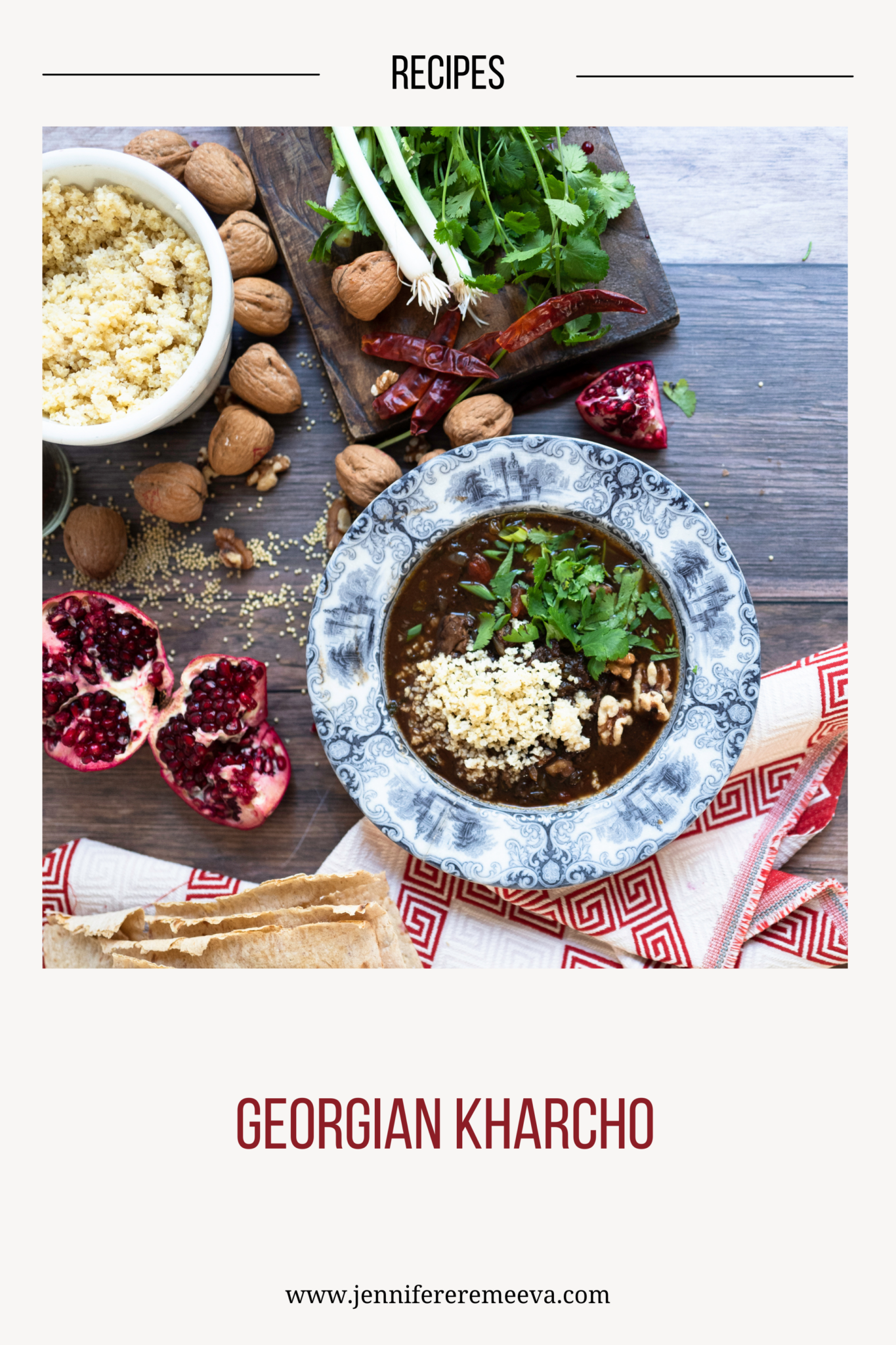Georgia’s tangy lamb soup marries tomatoes and pomegranates with walnuts and cilantro in an unforgettable soup that will transport you up to the peaks of the majestic Caucasus Mountains.
When it comes to matters culinary, Russians shed their xenophobia, just as they do their shoes when entering a friend’s home. The fact that current relations with former republics of the Soviet Union are less than cordial, has little or no bearing on the Russian appetite for Uzbek plov, Georgian khinkali, Estonian herring, or Crimean champagne. Classic Russian cuisine is not known for spices and exotic flavors, but over centuries, Russians have very successfully incorporated both the flavors and cooking techniques of their near neighbors into their own cooking through the import of signature dishes. The happy result for cooks and gourmands is that the pungent spices of Central Asia, and the musky, nutty flavors of the Caucuses are as ubiquitous as the thick sour cream and salted pickles of Russia.
Kharcho, a hearty and savory meat and tomato soup that almost qualifies as a stew, is a perfect example of a dish that is celebrated far beyond the borders of it’s native Georgia. In Russia, kharcho is as much a staple of the stolovaya, or workplace canteen as it is a fixture on an upscale restaurant menu, or a midweek favorite of a three-generation family. I’m particularly fond of it in winter, since nothing else quite warms you up like a hot bowl of kharcho after a day of trudging through the snow.
As always with soups, for every cook, there is a different kharcho recipe. There isn’t much agreement on the basic foundation ingredients: some say lamb, others insist on beef. The rice faction refuses to even discuss the merits of the more traditional millet or what one culinary historian argues is the original starch component: dried bread softened in yogurt. One thing is certain, however: kharcho gets its signature tangy sweet and sour layer of flavor from dried fruits. In the Former Soviet Union, this is sold as “plum paper” – thick sticky sheets of dried fruit skin, or its companion “apricot leather.” Acceptable substitutes include prunes, apricots, and pomegranate juice and tamarind rind. I used all four to get the right flavor.
If you plug for millet (my hands-down choice) try cooking it separately and then adding it into the soup just before serving. That way, the millet will not absorb all of the moisture and turn the soup into porridge. Be sure to have lots of fresh coriander, parsley, mint and dill for a generous garnish. Finally, kharcho is one of those dishes that taste even better the next day, and better still on the day after that. So, go ahead, make a lot!
Ingredients
- 2 large or 4 small lamb shanks about 1 kilo or two pounds of meat
- ¼- cup 60 ml + 2 Tbls of olive oil
- 1 head of garlic sliced in half + 5 cloves of garlic, finely chopped
- 2 yellow onions finely chopped
- 2 quarts 2 liters of beef stock
- 2 cups 475 ml of a robust red wine
- One 14-oz 410 ml tin of chopped tomatoes
- 2 Tbls of tomato paste
- 1 Tbls of salt and pepper
- 2 large red bell peppers chopped into a fine dice
- ¼- cup 60 ml of adjika
- 3.5- oz 100 grams of fruit leather sliced into small pieces (substitute the same amount of dried prunes, rehydrated with hot water and 25 grams of tamarind paste)
- ½- tsp of paprika
- ½- tsp of cayenne pepper
- 2 Tbls of khmeli-suneli
- 1 Tbls of fenugreek seeds crushed
- 2 cups 475 ml of pomegranate juice
- ¼- cup 60 ml of pomegranate syrup
- 1 cup 235 ml of finely chopped walnuts
Serve with
- Cooked millet*
Garnish with
- Freshly chopped cilantro mint, and parsley
- Freshly chopped scallions
- More chopped walnuts
Instructions
- Heat ¼-cup (60 ml) of the olive oil over medium high heat in a large, heavy-bottomed soup pot or Dutch oven. Salt and pepper the lamb shanks well, then sear them on each side until they are well browned.
- Remove the shanks to a plate, then lower the heat to medium. Pour the red wine into the pot and use the back of a wooden spoon to scrape up all the bits clinging to the bottom of the pan. Add the tomato paste and whisk to combine. Simmer until the mixture is reduced by half.
- Return the lamb shanks to the pot, then add the two halves of the garlic head, a quarter of the chopped onions, the chopped tomatoes, and enough of the beef stock so that the shanks are halfway covered. Bring the pot to a gentle simmer, then lower the heat as far as it will go, cover the pot tightly and allow the shanks to braise for 2-3 hours until the meat is falling off the bones. You can also do this in an oven set to 200ºF (95ºC). Check every 30 minutes to be sure that the liquid has not evaporated. Top up with more beef stock as needed.
- Remove the shanks from the braising liquid and use a fork to remove the lamb from the bones, then set the meat aside. Fork the lamb into bite-sized pieces. Remove the fat from the braising liquid by chilling it overnight or using a degreaser to separate the fatty liquid. Do not throw away the shank bones or the garlic head!
- Wipe out the pot and heat the remaining 2 Tbls of olive oil in it. Sauté the remaining onions until translucent. Then add the chopped garlic, bell peppers and sauté for a further 5-7 minutes until everything is quite limp. Sprinkle the mixture with the paprika and cayenne pepper and stir to combine. Then add the khmeli-suneli, fenugreek, and salt.
- Add the braising liquid and its solids, the remainder of the stock, the pomegranate juice and syrup to the pot and bring to a simmer. Add the lamb and lamb bones, the fruit leather, adjika, and the walnuts and stir well to combine. Cover and simmer over low heat for 45 minutes.
- While the soup is simmering, toast the millet in vegetable or olive oil until it is shiny, and a few grains go “pop.” Pour 1-¾ (410 ml) cups of water for every cup (235 ml) of millet with a pinch of salt. Simmer until the millet has absorbed all the liquid. Fluff the grains up.
Notes
Pin this Recipe!













After lunch time today, I’m printing this one out – it’s a keeper… Thankyou!
What a lovely winter soup!!!! So lucky to have tasted Kharcho right from your kitchen. I just hope i can recreate it and if it tastes half as good as yours I will be very happy.
Sorry if this is a silly question.
With the pomegranate juice, do you mean actual pomegranate juice – and half a litre of that needs quite a few pomegranates – or do you mean half a litre of the pomegranate juice drink that you commonly find in supermarkets?
Also, when I was last in Russia I found a concentrated pomegranate sauce that was really intense, I presume that I can substitute an appropriate amount of that diluted up to half a litre?
By the way, came here following a link on the email you sent. However, just to let you know, the blue links really didn’t show up very well against the green background on the email I received and it was only when I did a mouseover that I could read what the link said. Just trying to give some constructive feedback on the email, please feel free to delete this paragraph if you wish.
Looks great!
Thanks so much for this. This is an all time favorite. In NY there is a big Georgia/Uzbek/Russian population. It’s a wonderful soup for the winter.
This is definitely one of my favorites to cook whenever a relative comes in on our home during the winter. Thanks for sharing!